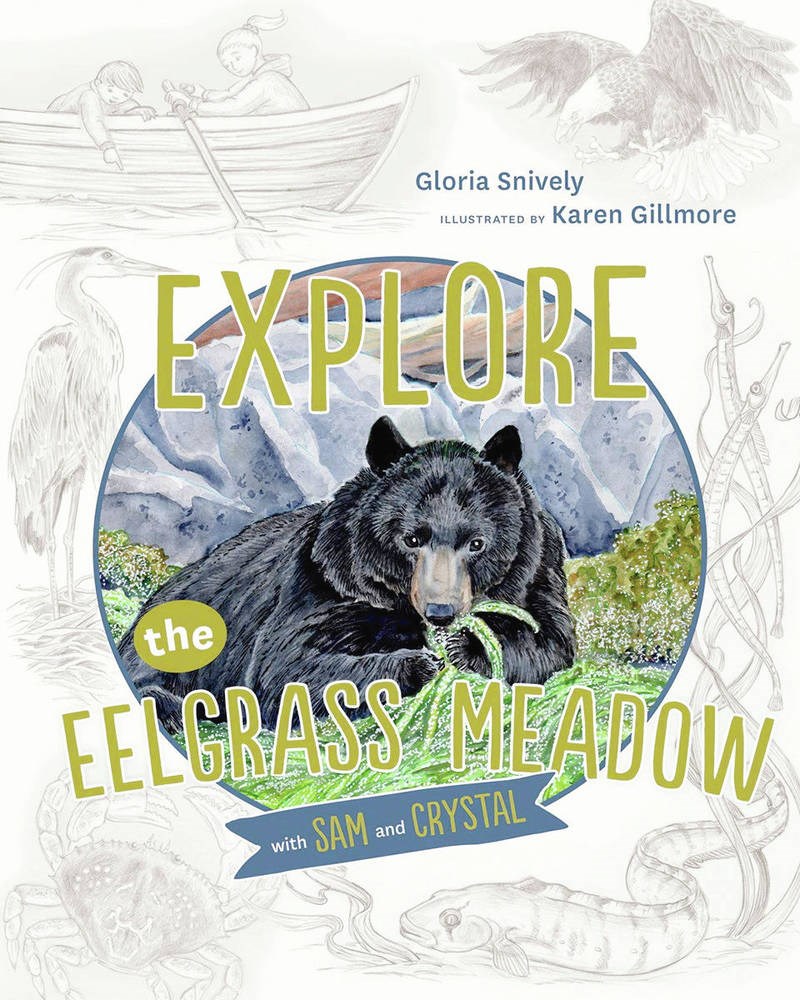We had a few warm days in May and I’m sure there’s more to come. When the heat reappears, you might enjoy taking a folding chair (with a drink holder) and a good book to the beach, and perhaps a child as well (if you know one), also with a good book.
With or without a child, you will be delighted and entertained by a series of locally written children’s books that are packed full of seaside facts — everything from the life cycle of the herring to heron rookeries, current ecosystem concerns and First Nation wisdom.
Written by local author and University of Victoria professor Gloria Snively and beautifully illustrated by Karen Gilmore, the books include Explore the Eelgrass Meadow with Sam and Crystal (2021); Explore the Rocky Shore (2018), and Explore the Wild Coast (2018), published by Heritage House.
They tell of the enchanting fantastical West Coast explorations and adventures of two children, Sam and Crystal. The children join their Uncle Charlie and Aunt Kate on their boat Blue Heron, and explore the little inlets and islets, coves and estuaries off southern British Columbia, often meeting up with their First Nation friend Ada, who shares her wonderful recipes and holds feasts, offering bannock, fish soup served in clam shells with wild beach peas, nettle tea and kelp chips.
As well, Ada passes on her knowledge of the natural world, advising the children: “When we stay still and listen to the seashore, the water, wind and animals, they can teach us things.”
The books are a unique blend of fiction and fantasy, at times almost dream-like, but with numerous magical discoveries of our coastal flora and fauna. Sam and Crystal explore glittering tidal pools and meet intriguing creatures within an eelgrass meadow enveloped with herring roe, venture inside a dark and slimy mysterious rock crevice, “Lady Octopus’s Sea Cave,” visit a giant kelp forest and swim through a dazzling sea-anemone garden. To accomplish this, they become fish and swim with the ancient sculpin fish who takes them on their fantastical journeys.
Grandfather Sculpin passes on his ancient wisdom of the sea and the creatures and plants that reside within it. Do you know how a sea cucumber defends itself? It “throws out its guts,” which Crystal thinks is “pretty gross.” And do you know of a little fish that builds nests and performs a “zig zag dance” to attract a female mate? It’s the three-spined sickleback.
There truly is something magical and calming about the sea — well, not always calming, as I once experienced on a hot summer’s day playing with my trolls on Galiano Island at my Gran’s place. She had a dear little yellow-painted cottage under a grove of arbutus trees and her lawn sloped onto a warm incline of sandstone that met the gentle, rippling waves at the bottom.
A sandstone beach is wonderful for children because it contains so many tidal pools. It was in one of these smoothly carved, perfectly oval pools that the trolls were having a lovely serene swim amongst the limpets, tiny snails and jewelled stones, each wearing a bathing cap made from a cut-off balloon, when a B.C. Ferry suddenly passed, creating a great surge of water that swept my 30 trolls out to sea!
I screamed as never before — the intrusion into my very real imaginary life was almost too much to bear as I watched my dear “family” bobbing helplessly in the dark green surf. Mum came tearing down onto the beach with a cigarette in her mouth and nothing much else on and she miraculously rescued each and every troll! I laid them all out on the warm sandstone and gave each one CPR and mouth-to-mouth resuscitation and they all lived!
Back on land, you may enjoy Johanna Wagstaffe’s excellent and informative book Fault Lines: Understanding the Power of Earthquakes (Orca Books, 2017). Wagstaffe, as you no doubt know, is the CBC’s jovial weather expert.
Her book, for both children and adults, is full of diagrams, maps, graphs and amazing photographs of some of the most devastating and severe quakes ever documented — for example, Turkey in 1999, Mexico in 1985 and British Columbia in 2015. She and others share personal stories, and her book provides an abundance of fascinating information on topics such as: “Can animals sense earthquakes before they happen?” and “Can one earthquake trigger another?”
(I recall a local earthquake a while back when I was on Glamorgan Farm in North Saanich. I didn’t feel a thing in the huge solid old log barn, but when I went into the Sidney Pharmacy, I was baffled to see that a mass of shampoo, mouthwash and other bodily supplies had crashed onto the floor, creating a rather colourful Northern Lights pattern on the beige linoleum).
Above all, Wagstaffe shares her views on preparation — “Be prepared, not scared,” she says, and I think that’s also good advice for life.



